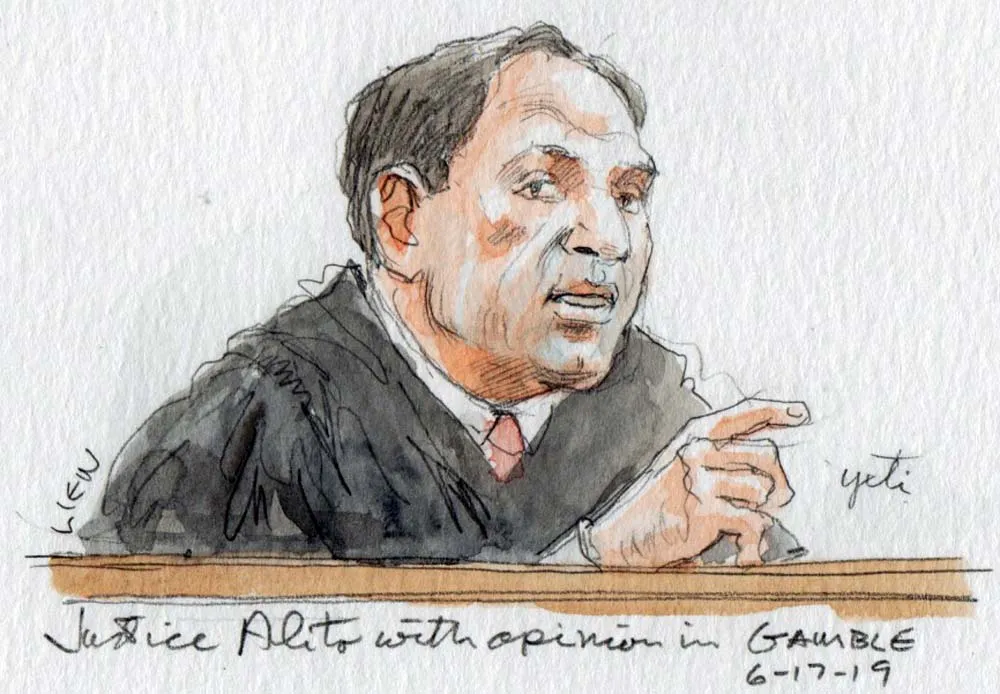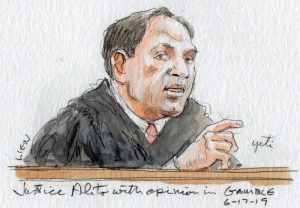Symposium: Party of five? Setting the table for Roe v. Wade

Melissa Murray is Professor of Law and Co-Faculty Director of the Birnbaum Women’s Leadership Network at New York University School of Law.
Last summer, Justice Anthony Kennedy’s retirement prompted a flurry of agonized predictions about the Supreme Court’s future, and more particularly, the future of reproductive rights. The confirmation hearings for Judge Brett Kavanaugh, the pick to replace Kennedy, reflected these anxieties. Women, their mouths taped and their bodies cloaked in red robes reminiscent of Margaret Atwood’s “The Handmaid’s Tale,” stood in silent vigil at the periphery of the Senate chamber. Others, unwilling to be silent, interrupted the proceedings to declare their support for reproductive rights. Suffice it to say that, even before the hearings evolved into a referendum on the #MeToo movement, the stakes were high, with commentators, including myself, predicting that Kavanaugh would be a fifth vote to overrule Roe v. Wade and decimate the right to abortion.
So, a year later, where are we? Although Roe survives, the changing composition of the court has emboldened opponents of reproductive rights to pass ever more restrictive laws regulating abortion. A number of state legislatures have enacted “heartbeat laws,” which prohibit abortion from the moment a fetal heartbeat can be detected — as early as six weeks, a time when a woman may not even know that she is pregnant. In this regard, these laws effectively function as pre-viability bans on abortion, in violation of Roe and Planned Parenthood v. Casey. Not to be outdone, Alabama recently enacted an aggressive law that criminalizes abortion providers and eschews the standard exceptions for rape and incest. All of these laws raise constitutional red flags. The fact that these laws, with all of their constitutional infirmities, have been enacted suggests that anti-abortion forces, emboldened by the court’s personnel changes, are spoiling for the fight that will overrule Roe once and for all.
The question, of course, is will the court take up this invitation to revisit Roe? This term suggests that the court, under Chief Justice John Roberts’ stewardship, may tread carefully. Early on, in a cert petition involving state Medicaid funding for Planned Parenthood and other health-care providers, Roberts and Kavanaugh joined the liberal wing in denying certiorari. That decision prompted a vehement dissent from Justice Clarence Thomas, who speculated that the majority’s eagerness to avoid hearing the case had “something to do with the fact that some respondents in these cases are named ‘Planned Parenthood.'”
Likewise, in an early motion in June Medical Services v. Gee, a challenge to a Louisiana law requiring abortion providers to have admitting privileges at local hospitals, the chief justice again joined the court’s liberals to uphold a stay, preventing the law from going into effect while the litigation was pending. But the chief justice’s willingness to go his own way on such fraught issues does not mean that the future of reproductive rights is assured.
Critically, the Louisiana law challenged in June Medical Services was an admitting-privileges requirement that was virtually identical to the Texas admitting-privileges law that the court struck down in 2016’s Whole Women’s Health v. Hellerstedt. The mere fact that a lower court upheld the Louisiana law in the face of an extant precedent invalidating a virtually identical admitting-privileges requirement makes clear the precarious state of abortion jurisprudence, and more troublingly, the willingness of lower courts to challenge, question and defy these precedents. Indeed, in Box v. Planned Parenthood, an appeal of two Indiana abortion restrictions, Judge David Manion voted with two other members of the U.S. Court of Appeals for the 7th Circuit to invalidate the challenged laws, but wrote separately to emphasize that he did so only because extant precedent “compelled” this result. Noting that “[o]nly the Supreme Court or a constitutional amendment” could remove the “insurmountable” precedents that required lower courts to strike down abortion regulations, Manion appeared to issue an invitation — or a directive — to the court to take up the abortion question once again.
Some members of the court seem eager to take up the invitation to reconsider Roe — and other extant precedents. In its review of the 7th Circuit’s disposition of the two Indiana abortion laws at issue in Box, the court, in a per curiam opinion, upheld the provision requiring the interment or cremation of fetal remains, while denying certiorari on a challenge to the second provision, which banned abortions performed solely on the basis of a fetus’s gender, race, ethnicity or disabilities. In a stinging concurrence, Thomas sought to link Margaret Sanger, the early birth-control movement, and the eugenics movement to abortion. As he explained, just as the early interest in contraception was linked to a Darwinian effort to cull “undesirable” traits from the broader population, modern-day abortion procedures are “rife with the potential for eugenic manipulation.”
Thomas’ concurrence is notable on multiple fronts. As an initial matter, it is an extraordinary effort to launch an alternative narrative for abortion opposition — one that may have greater purchase with those who have been skeptical of claims that restrictive abortion regulations are necessary to secure women’s health. In offering an alternative frame for abortion opposition, Thomas’ eugenics narrative also drives a wedge between the racial-justice and disabilities-rights communities and the pro-choice community. Finally, the abortion-as-eugenics framing abandons the anti-abortion movement’s characterization of women as unwitting victims of callous abortion providers and instead recasts them as potential eugenicists determined to avoid giving birth to the “wrong” sort of child.
But perhaps most notable about Thomas’ concurrence in Box is its relationship to his other separate writings from this term. In Gamble v. United States, which considered the separate-sovereigns exception to double jeopardy, Thomas wrote separately “to address the proper role of the doctrine of stare decisis.” As he explained, the current formulation of stare decisis undermines the Supreme Court’s Article III duties because “it elevates demonstrably erroneous decisions … over the text of the Constitution and other duly enacted federal law.” Under this new formulation of stare decisis, the court is under no obligation to follow “demonstrably erroneous” precedents; indeed, when confronted with such a precedent, the court is duty-bound to “correct the error, regardless of whether other factors support overruling the precedent.” Meaningfully, in offering this muscular vision of stare decisis and the judicial role, Thomas takes direct aim at Casey, the 1992 case that not only upheld the right to an abortion first recognized in Roe, but also identified a series of factors that courts must weigh in determining whether overruling an extant precedent is warranted.

Thus, while the chief justice’s efforts to avoid the abortion issue may have cheered progressives, Thomas’ separate writings this term should temper any pro-choice optimism. In Box, Thomas advances an alternative argument — abortion’s eugenics potential — for overruling Roe, while proposing in Gamble reconfigured rules by which the Supreme Court considers its obligation to adhere to precedent. Taken together, these two opinions sketch an alarming blueprint for unraveling reproductive rights.
And make no mistake about it, the upcoming terms will provide ample opportunities for Thomas and others to entrench these views — and in so doing, to cobble together a majority to overrule Roe or simply whittle down the abortion right to the point of inconsequence. Coming down the pike are a range of cases that squarely confront the question of Roe‘s continued vitality. If five members of the court are amenable to Thomas’ entreaties to revisit the rules of stare decisis and his concerns about the eugenics potential of abortion, then almost any of these cases are plausible candidates to rule Roe out of existence.
With all of this in mind, we might think of OT 2018 as an exercise in table-setting. Despite the chief justice’s best efforts to avoid controversial rulings, Thomas has emerged as the consummate host, carefully laying a table complete with all the implements needed to partake of a jurisprudential buffet in which the traditional notion of stare decisis, Roe and a host of other precedents are up for grabs. With new colleagues on the right, Thomas is ready to feast. The question going forward will be whether he can persuade the chief justice to join him.
Cases: Gamble v. United States, June Medical Services LLC v. Russo, Box v. Planned Parenthood of Indiana and Kentucky Inc.
